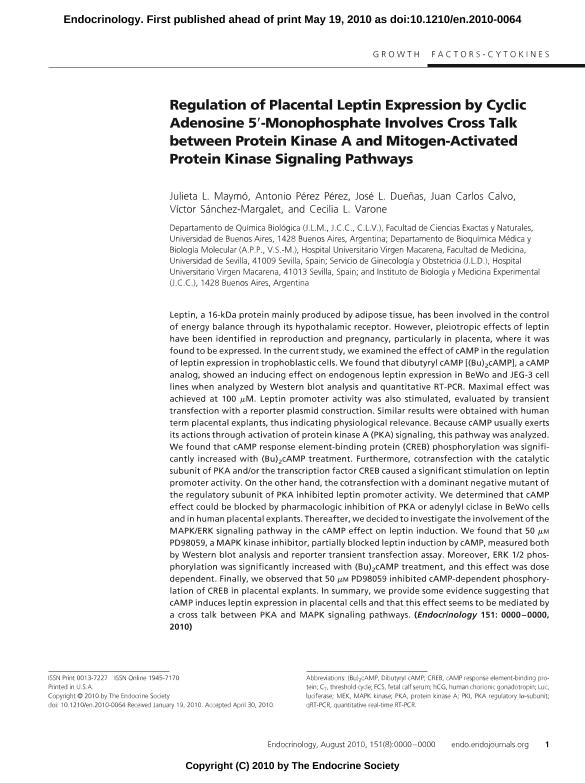Mostrar el registro sencillo del ítem
dc.contributor.author
Maymo, Julieta Lorena

dc.contributor.author
Pérez Pérez, Antonio
dc.contributor.author
Dueñas, José L.
dc.contributor.author
Calvo, Juan Carlos

dc.contributor.author
Sánchez Margalet, Víctor
dc.contributor.author
Varone, Cecilia Laura

dc.date.available
2018-12-18T18:17:02Z
dc.date.issued
2010-08
dc.identifier.citation
Maymo, Julieta Lorena; Pérez Pérez, Antonio; Dueñas, José L.; Calvo, Juan Carlos; Sánchez Margalet, Víctor; et al.; Regulation of placental leptin expression by cyclic adenosine 5′-monophosphate involves cross talk between protein kinase A and mitogen-activated protein kinase signaling pathways; Endocrine Society; Endocrinology; 151; 8; 8-2010; 3738-3751
dc.identifier.issn
0013-7227
dc.identifier.uri
http://hdl.handle.net/11336/66675
dc.description.abstract
Leptin, a 16-kDa protein mainly produced by adipose tissue, has been involved in the control of energy balance through its hypothalamic receptor. However, pleiotropic effects of leptin have been identified in reproduction and pregnancy, particularly in placenta, where it was found to be expressed. In the current study, we examined the effect of cAMP in the regulation of leptin expression in trophoblastic cells. We found that dibutyryl cAMP [(Bu) 2cAMP], a cAMP analog, showed an inducing effect on endogenous leptin expression in BeWo and JEG-3 cell lines when analyzed by Western blot analysis and quantitative RT-PCR. Maximal effect was achieved at 100 μM. Leptin promoter activity was also stimulated, evaluated by transient transfection with a reporter plasmid construction. Similar results were obtained with human term placental explants, thus indicating physiological relevance. Because cAMP usually exerts its actions through activation of protein kinase A (PKA) signaling, this pathway was analyzed. We found that cAMP response element-binding protein (CREB) phosphorylation was significantly increased with (Bu)2cAMP treatment. Furthermore, cotransfection with the catalytic subunit of PKA and/or the transcription factor CREB caused a significant stimulation on leptin promoter activity. On the other hand, the cotransfection with a dominant negative mutant of the regulatory subunit of PKA inhibited leptin promoter activity. We determined that cAMP effect could be blocked by pharmacologic inhibition of PKA or adenylyl ciclase in BeWo cells and in human placental explants. Thereafter, we decided to investigate the involvement of the MAPK/ERK signaling pathway in the cAMP effect on leptin induction. We found that 50 μM PD98059, a MAPK kinase inhibitor, partially blocked leptin induction by cAMP, measured both by Western blot analysis and reporter transient transfection assay. Moreover, ERK 1/2 phosphorylation was significantly increased with (Bu)2cAMP treatment, and this effect was dose dependent. Finally, we observed that 50 μM PD98059 inhibited cAMP-dependent phosphorylation of CREB in placental explants. In summary, we provide some evidence suggesting that cAMP induces leptin expression in placental cells and that this effect seems to be mediated by a cross talk between PKA and MAPK signaling pathways. Copyright © 2010 by The Endocrine Society.
dc.format
application/pdf
dc.language.iso
eng
dc.publisher
Endocrine Society

dc.rights
info:eu-repo/semantics/openAccess
dc.rights.uri
https://creativecommons.org/licenses/by-nc-sa/2.5/ar/
dc.subject
Leptin
dc.subject
Camp
dc.subject
Placenta
dc.subject
Gene Expression
dc.subject.classification
Otras Ciencias Biológicas

dc.subject.classification
Ciencias Biológicas

dc.subject.classification
CIENCIAS NATURALES Y EXACTAS

dc.title
Regulation of placental leptin expression by cyclic adenosine 5′-monophosphate involves cross talk between protein kinase A and mitogen-activated protein kinase signaling pathways
dc.type
info:eu-repo/semantics/article
dc.type
info:ar-repo/semantics/artículo
dc.type
info:eu-repo/semantics/publishedVersion
dc.date.updated
2018-11-22T15:28:47Z
dc.journal.volume
151
dc.journal.number
8
dc.journal.pagination
3738-3751
dc.journal.pais
Estados Unidos

dc.journal.ciudad
Menasha
dc.description.fil
Fil: Maymo, Julieta Lorena. Consejo Nacional de Investigaciones Científicas y Técnicas. Oficina de Coordinación Administrativa Ciudad Universitaria. Instituto de Química Biológica de la Facultad de Ciencias Exactas y Naturales. Universidad de Buenos Aires. Facultad de Ciencias Exactas y Naturales. Instituto de Química Biológica de la Facultad de Ciencias Exactas y Naturales; Argentina
dc.description.fil
Fil: Pérez Pérez, Antonio. Universidad de Sevilla; España
dc.description.fil
Fil: Dueñas, José L.. Hospital Universitario Virgen Macarena; España
dc.description.fil
Fil: Calvo, Juan Carlos. Consejo Nacional de Investigaciones Científicas y Técnicas. Instituto de Biología y Medicina Experimental. Fundación de Instituto de Biología y Medicina Experimental. Instituto de Biología y Medicina Experimental; Argentina
dc.description.fil
Fil: Sánchez Margalet, Víctor. Universidad de Sevilla; España
dc.description.fil
Fil: Varone, Cecilia Laura. Consejo Nacional de Investigaciones Científicas y Técnicas. Oficina de Coordinación Administrativa Ciudad Universitaria. Instituto de Química Biológica de la Facultad de Ciencias Exactas y Naturales. Universidad de Buenos Aires. Facultad de Ciencias Exactas y Naturales. Instituto de Química Biológica de la Facultad de Ciencias Exactas y Naturales; Argentina
dc.journal.title
Endocrinology

dc.relation.alternativeid
info:eu-repo/semantics/altIdentifier/doi/https://dx.doi.org/10.1210/en.2010-0064
dc.relation.alternativeid
info:eu-repo/semantics/altIdentifier/url/https://academic.oup.com/endo/article/151/8/3738/2456896
Archivos asociados
